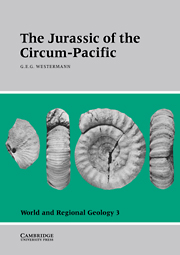Book contents
- Frontmatter
- Contents
- List of contributors
- Preface
- Acknowledgments
- Introduction
- Part I Time scales
- Part II Circum-Pacific base map
- Part III Regional geology and stratigraphy
- 4 Western Canada and United States
- 5 Meso-America
- 6 Western South America and Antarctica
- 7 Australasia
- 8 Indonesia and Papua New Guinea
- 9 Southeast Asia and Japan
- 10 Eastern China
- 11 Eastern Russia
- Part IV Biochronology
- Part V Biogeography
- Part VI Climatology and oceanography
- Appendix: Biochronology and atlas with index and guide fossils
- General Index
- Index of Guide- and Indexfossils
9 - Southeast Asia and Japan
Published online by Cambridge University Press: 04 August 2010
- Frontmatter
- Contents
- List of contributors
- Preface
- Acknowledgments
- Introduction
- Part I Time scales
- Part II Circum-Pacific base map
- Part III Regional geology and stratigraphy
- 4 Western Canada and United States
- 5 Meso-America
- 6 Western South America and Antarctica
- 7 Australasia
- 8 Indonesia and Papua New Guinea
- 9 Southeast Asia and Japan
- 10 Eastern China
- 11 Eastern Russia
- Part IV Biochronology
- Part V Biogeography
- Part VI Climatology and oceanography
- Appendix: Biochronology and atlas with index and guide fossils
- General Index
- Index of Guide- and Indexfossils
Summary
The main part of the Eurasian continent was above sea level during the Jurassic. Continental deposits are widely distributed on the continental nucleus of China and surrounding areas, whereas marine Jurassic occurs mostly at the continental margins. There are narrow Jurassic exposures in northeastern China, Hongkong, and the Indochinese Peninsula that represent ingressions onto the continental areas. The Jurassic deposits of Japan, the Philippines, Sulawesi, and Kalimantan, as well as the Thai–Burmese border region, Yunnan, and Tibet, were largely under open-sea conditions, consisting mostly of orogenic sediments.
JAPAN
Tectonostratigraphic terranes
The areas of the Jurassic exposures in Japan can be classified into six blocks or terranes, each with more or less characteristic lithology, sequence, and faunas. This is a reflection of the complicated tectonic setting of the Japanese Jurassic (Figure 9.1).
Hida Terrane. The Hida Terrane includes the Hida and Hida Marginal Belts in the northern part of central Japan and their westward extension in Chugoku. The Jurassic is exposed in isolated local basins. The Toyora, Tetori, and Kuruma areas are major basins located along the boundary of the Hida and Hida Marginal Belts, and the smaller Higuchi and Yamaoku areas are in the Paleozoic belt of Chugoku and the Sangun Belt, respectively.
Tamba Terrane. The Tamba Terrane (Tamba, Mino, Kiso, Ashio, and Yamizo provinces) is a narrow belt stretching on the northern side of the Median Tectonic Line, occupying the axial part of Southwest Japan and its northeastward extension in Northeast Japan.
- Type
- Chapter
- Information
- The Jurassic of the Circum-Pacific , pp. 194 - 213Publisher: Cambridge University PressPrint publication year: 1993
- 4
- Cited by



